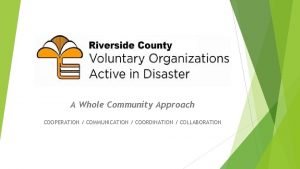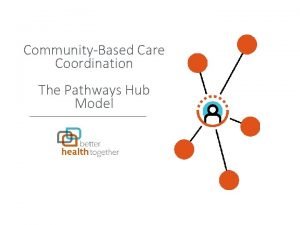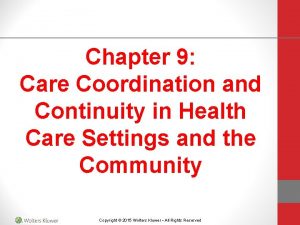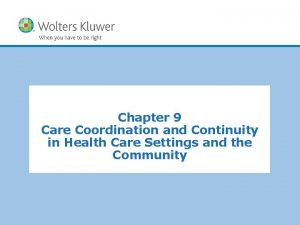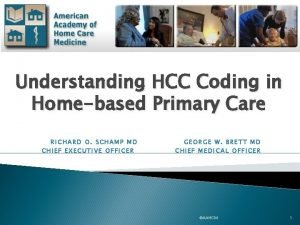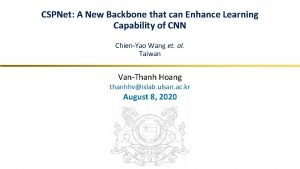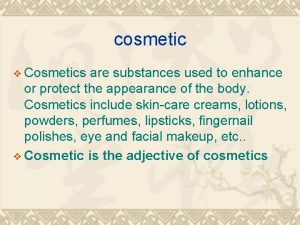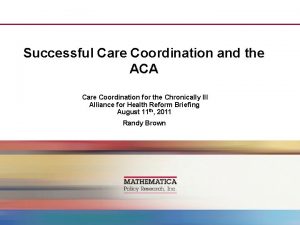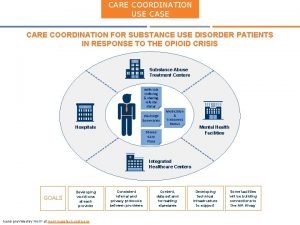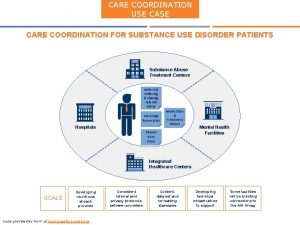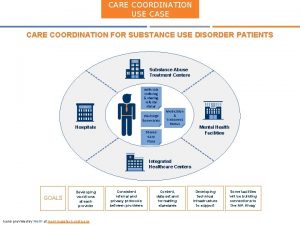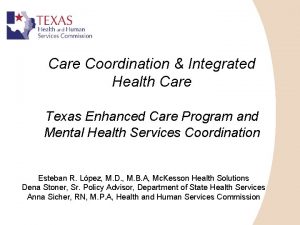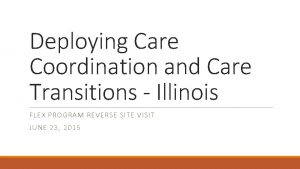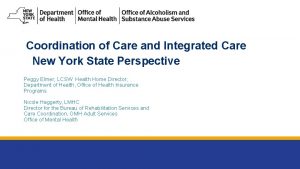Who Cares Care coordination and cooperation to enhance
























- Slides: 24

Who Cares? Care coordination and cooperation to enhance quality in elderly care in the European Union Conference on Healthy and Dignified Ageing Swedish Presidency of the EU 15 -16 September 2009 Prof. Dr. Bernd Marin

Long-term care in the EU today § Long-term care: a late-comer in social protection systems § Diversity and common trends in the EU § Key policy challenges and good practices: § § § § Better integration between health and long-term care Improved access to care for dependent old-age people Choice in publicly provided services Long-term care workforce policies Alzheimer diseases and other dementia Quality of services, quality assessment/control/assurance Instant JIT responsiveness, timeliness, delivery when needed Ageing in place and grace: dignity, respect, TLC 15 -16/09/2009 Conference on Healthy and Dignified Ageing – Swedish Presidency of the EU 2

Long-term care: a late-comer § “Young” subject § Arguably the social policy area where EU Member Countries differ the most § First steps as a differentiated policy field § Common challenges interest in good practices § Key issues for developing long-term care in the EU: § Enhanced coordination/integration of health and social care; § User-oriented approach. 15 -16/09/2009 Conference on Healthy and Dignified Ageing – Swedish Presidency of the EU 3

How many receive care in institutions? Share of older people receiving care in institutions (most recent date) Institutional care covers only a small percentage of older people 6. 5% Source: Huber et al. (2009 forthcoming) Own calculations based on OECD, NOSOSCO , WHO, Eurostat and national sources. 15 -16/09/2009 Conference on Healthy and Dignified Ageing – Swedish Presidency of the EU 4

Home is where you’re cared for Share of older people receiving long-term care services at home (most recent date) Different approaches to care Source: Huber et al. (2009 forthcoming) Own calculations based on OECD, NOSOSCO , WHO, Eurostat and national sources. 15 -16/09/2009 Conference on Healthy and Dignified Ageing – Swedish Presidency of the EU 5

Providing more people with care Share of older people receiving care at home and in as institutional setting (most recent date) Publicly provided care at home: the key for wider access to care Source: Own calculations based on OECD, NOSOSCO , WHO, Eurostat and national sources. 15 -16/09/2009 Conference on Healthy and Dignified Ageing – Swedish Presidency of the EU 6

Differences in informal care giving Percentage of the population aged 15+ providing informal care to a co-resident relative aged 60+ (1999) Labour of love Intimacy at a distance Source: Huber et al. (2009, forthcoming) Own calculations based on Walker (1999). 15 -16/09/2009 Conference on Healthy and Dignified Ageing – Swedish Presidency of the EU 7

Overburdened carers EUROBAROMETER (2007) In your opinion, do dependent older people rely too much on their relatives? Lack of care services… Providing care to co-residents… … explaining carers’ burden? Source: EUROBAROMETER (2007) 15 -16/09/2009 Conference on Healthy and Dignified Ageing – Swedish Presidency of the EU 8

Mid-life challenges Providing care for older family members by country and age group Source: OECD (2005), EUROFAMCARE national reports. 15 -16/09/2009 Conference on Healthy and Dignified Ageing – Swedish Presidency of the EU 9

Reconciling work and care On an individual level: remains difficult Employment status of main carers by country and domain On a policy level: can the Lisbon Strategy and support to carers co-exist? Source: National sources, EUROFAMCARE national reports, Lamura et al. (2006). 15 -16/09/2009 Conference on Healthy and Dignified Ageing – Swedish Presidency of the EU 10

How much and where are we spending? Public expenditure on long-term care and its distribution between home and institutional care (most recent date) Paradox: most people cared for at home. . . most public resources devoted to institutional care Public resources: § A diverse picture § Modest amounts dedicated to care: EU 15 spends 7. 6% on health and 9. 1% on old-age pensions alone Source: Huber et al. (2009, forthcoming) Own calculations based on OECD, NOSOSCO , Eurostat and national sources. 15 -16/09/2009 Conference on Healthy and Dignified Ageing – Swedish Presidency of the EU 11

Making sense of differences in expenditure Relation between expenditure on old-age institutional care and share of older people benefiting from it, 2007 Different private public mixes in expenditure Differences in quality Source: Huber et al. (2009 forthcoming) Own calculations based on OECD, NOSOSCO, Eurostat and national sources. 15 -16/09/2009 Conference on Healthy and Dignified Ageing – Swedish Presidency of the EU 12

How deep is the beneficiaries’ pocket? User’s fee for institutional care, in percentage of the APW net wage (2007*) Paying for institutional care (EU level): 51. 2% of public resources devoted to 3. 3% of 65+. . . yet, heavy private contributions still required. Source: Huber et al. (2009 forthcoming) Own calculations based on national sources. 15 -16/09/2009 Conference on Healthy and Dignified Ageing – Swedish Presidency of the EU 13

Trade-offs in benefit generosity Amounts of attendance allowances in percentage of net wage of APW and its beneficiaries (2007 or most recent date) Higher but targeted amounts “Generous”? Smaller portions of the pie Source: Huber et al. (2009, forthcoming). 15 -16/09/2009 Conference on Healthy and Dignified Ageing – Swedish Presidency of the EU 14

The challenge of coordination and integration Overcoming barriers Nurs Gener ing al Hospital Hom Practiti e oner Care Health Care System differentiated, professionalised, hierarchical, funded, rights-based Short Day term Care Resident ial Care Other Home Services, Help Housing, etc. Social Care System local, less professionalised, badly funded, discretional 15 -16/09/2009 Conference on Healthy and Dignified Ageing – Swedish Presidency of the EU 15

An example of good practice Skævinge (Denmark): The Health Centre ‘Bauneparken 24 -hour integrated health and social care Short term Care Hospital General Practition er Residential Care Nursing Home Care Home Help How: § Person-centred § Single point of contact § Case management § Self-care and prevention 15 -16/09/2009 Day Care Other Services, Housing, etc. Conference on Healthy and Dignified Ageing – Swedish Presidency of the EU Outcomes: § No waiting time § Room for specialized services § Reduced hospital stays § Below average use of resources 16

Accessing mainstream health § Dependent older people facing barriers in access Low expectations Regulations Age discrimination Mobility Poverty Gaps in geriatrician’s training § Major improvements should be possible in rehabilitation and mental health § Specialised research in health care for older people needed 15 -16/09/2009 Conference on Healthy and Dignified Ageing – Swedish Presidency of the EU 17

Having a choice on care Pathways to increased consumer choice: § Empowering people with a budget § Opening the care market to private providers Challenges: § Limits in using informal carers § Ensuring “market thickness” § Concentration of providers What have we learned from care markets? 15 -16/09/2009 Conference on Healthy and Dignified Ageing – Swedish Presidency of the EU 18

Long-term care workforce § Long-term care workers are crucial for quality § Care services as a “job machine” However: § Concerns remain over labour shortages § Informal markets of care § Can immigration fill the gap? Need for: § Increased skills § Better working and paying conditions 15 -16/09/2009 Conference on Healthy and Dignified Ageing – Swedish Presidency of the EU 19

Alzheimer and other dementia Why Alzheimer and other dementia matter? Improved dementia assessment and care… … but tailored training of carers and improved early detection is still needed Prevalence of dementia in Europe, by age-groups (2005) Source: Alzheimer Europe (2006) based on Ferri et al. (2005). 15 -16/09/2009 Conference on Healthy and Dignified Ageing – Swedish Presidency of the EU 20

Privacy in care home Where dignity of care and quality of living come together Percentage of people living in rooms (institutional care), by number of beds per room Percentage of people living in rooms (institutional care) by number of beds per room Source: National sources and OECD (2005) 15 -16/09/2009 Conference on Healthy and Dignified Ageing – Swedish Presidency of the EU 21

Future ageing in the older age groups Current and projected share of the population aged 80+, 2006 and 2050 (selected countries) Huber et al. (2009) based on Eurostat EUROPOP 2008. 15 -16/09/2009 Conference on Healthy and Dignified Ageing – Swedish Presidency of the EU 22

Ageing and public expenditure in long-term care Ageing and public expenditure on long-term care, 2007 Source: Huber et al. (2009, forthcoming) Own calculations based on OECD, NOSOSCO , Eurostat and national sources. 15 -16/09/2009 Conference on Healthy and Dignified Ageing – Swedish Presidency of the EU 23

Trade-offs in benefit generosity Amounts of care allowances in percentage of net wage of APW and its beneficiaries (2007 or most recent date) Source: Huber et al. (2009, forthcoming). 15 -16/09/2009 Conference on Healthy and Dignified Ageing – Swedish Presidency of the EU 24
 Communication coordination cooperation during the emergency
Communication coordination cooperation during the emergency Communication cooperation coordination collaboration
Communication cooperation coordination collaboration Coordination position isomerism
Coordination position isomerism Primary secondary and tertiary care
Primary secondary and tertiary care Grammar to enrich and enhance writing
Grammar to enrich and enhance writing Pathways community hub model
Pathways community hub model Care coordination ring
Care coordination ring Intersectoral coordination in primary health care
Intersectoral coordination in primary health care Isbarq example
Isbarq example Care coordination models
Care coordination models Fashion cycle
Fashion cycle Enhance an image
Enhance an image Cspnet
Cspnet Cosmetics are substances that are used to enhance……..
Cosmetics are substances that are used to enhance…….. Enhance an image
Enhance an image Nyjc subject combination
Nyjc subject combination Enhance life
Enhance life Salad that stimulate the appetite of your guests
Salad that stimulate the appetite of your guests Nnn hypno
Nnn hypno Gmcares
Gmcares No one cares
No one cares Is imana cares legit
Is imana cares legit Lorax hot
Lorax hot Cares rebar
Cares rebar Cares engagement network
Cares engagement network

